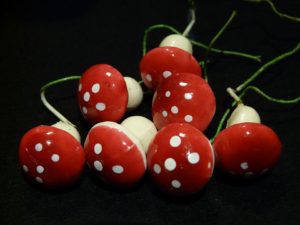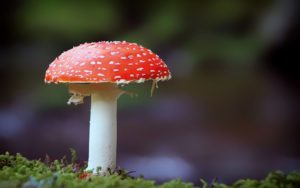Maybe reindeer only think they’re flying
Last year my neighbor, who grows and sells mushrooms – legal ones – for a living, suggested I do an article on a Christmas fungus that could account for some of the magical features of that holiday tradition. Initially I brushed off his idea, thinking maybe he had consumed some bad stock that day, but since then I have come across a fair bit of evidence to support his idea.

Amanita muscaria ornaments. Photo: Pixabay
Distributed across North America, Europe, and Asia from temperate zones into the far north, Amanita muscaria is a mushroom which grows among pine, birch and oak trees. It is in fact a symbiont of the roots of those trees, using a small amount of sugar from their roots but vastly increasing the trees’ ability to absorb nutrients and water. It is unable to grow outside of a forest setting.
Sometimes called the fly agaric or fly amanita because it has been used to kill flies, A. muscariais a big, beautiful reddish (sometimes yellow) mushroom. Its domed cap, which flattens as it matures, is dotted with large white spots, making it one of the most recognizable toadstools or free-standing mushrooms in the world. It is the big polka-dotted mushroom of Alice in Wonderland, coloring books, and garden statuary. Even the caps of gnomes are often painted to look like the fly agaric mushroom.
Amanita muscaria also has psychoactive properties, and has been consumed for thousands of years by winter-weary Laplanders as a pick-me-up; by Siberian shaman and other practitioners in healing rituals; and by wild reindeer for—well we’re not sure. Possibly to fly, but more on that later. Certainly there are many accounts of reindeer acting “drunk” after browsing that ‘shroom.

Amanita muscaria. Photo Pixabay
If the name Amanita rings a bell, it might be due to the fact that the so-called death-cap, maybe the most poisonous mushroom in the world, is a close relative, Amanita phalloides. The death-cap is native to Europe and Asia, but has been accidentally introduced with imported trees to a few locations in North America. Unlike the case with many fungi, its toxin is not neutralized by heat, and a half of a cap is enough to destroy the liver and kidneys of an adult human, making the only “antidote” an organ transplant.
In addition to being psychoactive, our cheerful fly agaric is also toxic, though less so. And it seems it can be rendered “safer” (reports say it may still cause vomiting) by gentle heat or dehydration. Apparently, too much heat takes all the fun out of the fly agaric, as it has been used as a culinary mushroom once it was pre-boiled and the initial water discarded. Reportedly, in Siberia and other regions, A. muscaria was placed in stockings and hung near the fire. This way the moderate heat would render them (mushrooms, not stockings) safe to use ceremonially or otherwise.
Stockings full of red-and-white mushrooms hung by the chimney with care sounds uncomfortably familiar. And yes, Father Christmas may wear a red and white outfit and may or may not surround himself with short, squat, mushroom-esque elves, but I was skeptical about any fungal connection with winter holiday traditions. However, a simple a web-image search for “mushroom decoration Christmas” turned up a bazillion (well, 30,800,000) pictures of Amanita muscaria tree ornaments and made me a believer.
 In Cheech Marin and Tommy Chong’s hilarious 1971 skit “Santa and His Old Lady,” Cheech explains Santa Claus, “the guy with the hairy jaws,” to his friend. Santa’s flying sleigh, according to Cheech, is fueled by “magic dust,” with “a little for the reindeer, a little for Santa, a little more for Santa, a little morefor Santa…” Maybe in addition to the stuff they liked to smoke, they also knew about fly agaric.
In Cheech Marin and Tommy Chong’s hilarious 1971 skit “Santa and His Old Lady,” Cheech explains Santa Claus, “the guy with the hairy jaws,” to his friend. Santa’s flying sleigh, according to Cheech, is fueled by “magic dust,” with “a little for the reindeer, a little for Santa, a little more for Santa, a little morefor Santa…” Maybe in addition to the stuff they liked to smoke, they also knew about fly agaric.
In the interest of public health, I want to caution against trying this fungus. For one thing, references indicate fly agaric mushrooms picked in spring and summer can be 10 times more potent than those gathered in fall. And that a miscalculation could leave you sick for a week or more. And no, I have not tried A. muscariaand have no plans to do so.
I am no scholar, but I do find it interesting that the more secular trappings of our modern Christmas have a connection to ancient winter traditions in Siberia.Amanita muscariamay help explain Santa’s unnatural jolliness, his magical flight, not to mention the choice of colors for his suit, and the millions of Christmas mushroom ornaments are overtly connected.
My advice would be to avoid toxic fungi as well as retail toxicity, and to aim for some old-fashioned cheer not driven by stuff of one kind or other. The reindeer, of course, will make their own choices.
Paul Hetzler is a horticulture and natural resources educator with Cornell Cooperative Extension of St. Lawrence County.






.jpg)
